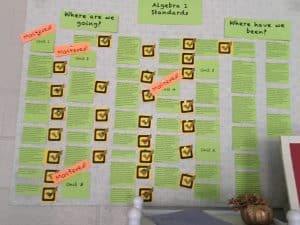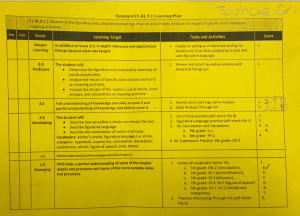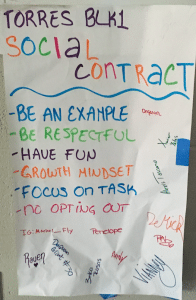Charleston: A Conversation with Teachers at Stall High School
CompetencyWorks Blog
 This is the fourth post in my site visit to Charleston County School District in South Carolina. Read the first post on building the CCSD framework, the second on implementation strategies, and schools Pepperhill Elementary, Stall High, Goodwin Elementary, and Pinehurst Elementary.
This is the fourth post in my site visit to Charleston County School District in South Carolina. Read the first post on building the CCSD framework, the second on implementation strategies, and schools Pepperhill Elementary, Stall High, Goodwin Elementary, and Pinehurst Elementary.
Our first stop at Stall High School was to visit with Hannah Studemeyer, a Personalized Learning Coach. On the wall was the Progression of Implementation, the district roadmap for implementing competency-based, personalized learning. Kristen Brittingham, Director of Personalized Learning, explained the Progression is important because it provides alignment and transparency with the transition to a competency based personalized learning system. For each step in the Progression, Charleston has developed a training module and a proficiency scale that provides the practical direction needed for implementation. Each school then creates a plan specific to the needs of their student population, existing programs and digital resources, readiness of teachers, etc. No two schools implementing personalized learning look exactly the same.
 Dr. Brittingham and Ms. Studemeyer noted an important first step in the journey is to develop a learner-centered climate and culture where students learn the skills they need to become self-directed learners, a necessary component for ensuring success with personalized learning. Stall’s schoolwide shared vision, “R. B. Stall will be an innovative learning community that inspires all to build a better future,” embraces this philosophy. Principal Kim Wilson and his leadership team are committed to seeing their vision become a reality by using it to guide all of their decision making. “Our school shared vision is the lens through which we make all our decisions, if something doesn’t fit into our vision to Inspire, Innovate & Learn, we don’t do it,” explained Wilson.
Dr. Brittingham and Ms. Studemeyer noted an important first step in the journey is to develop a learner-centered climate and culture where students learn the skills they need to become self-directed learners, a necessary component for ensuring success with personalized learning. Stall’s schoolwide shared vision, “R. B. Stall will be an innovative learning community that inspires all to build a better future,” embraces this philosophy. Principal Kim Wilson and his leadership team are committed to seeing their vision become a reality by using it to guide all of their decision making. “Our school shared vision is the lens through which we make all our decisions, if something doesn’t fit into our vision to Inspire, Innovate & Learn, we don’t do it,” explained Wilson.
Each classroom has developed a social contract or shared vision, which is their class goal; a code of cooperation, which delineates actions needed to reach their goal; and standard operating procedures, which identify processes that allow students to become independent learners. These actions have fundamentally changed the learning environment at Stall High School, and have been an important first step in implementing personalized learning.
 The school is currently working on making learning transparent and accessible for students. This is being accomplished by unpacking proficiency scales with students, conducting pre-assessments, creating flexible instructional groups based on data, aligning assignments to the progression of learning, providing formative feedback and gathering evidence of learning. Teachers and students capture this information on Learning Plans that enable students to guide and individualize their learning.
The school is currently working on making learning transparent and accessible for students. This is being accomplished by unpacking proficiency scales with students, conducting pre-assessments, creating flexible instructional groups based on data, aligning assignments to the progression of learning, providing formative feedback and gathering evidence of learning. Teachers and students capture this information on Learning Plans that enable students to guide and individualize their learning.
A Conversation with High School Teachers
During the day, I had the opportunity to speak with Morgan Castagnasso, Science; Taylor Longman, English; Lauren King, Special Education; Chloe Leech, Math; Brittany Lester, Math; Kim Wilson, Principal; Virginia Sayer, Assistant Principal; Kristen Brittingham, Director of Personalized Learning and Rebecca Mestaz, Marzano Research Coach.
I visited several classrooms and saw many of the practices of personalized learning in action including use of a shared vision, social contract, code of cooperation, standard operating procedures, learning plans, aligned assessments, learning pathways and flexible learning environments. In Ms. Leech’s classroom, two student ambassadors noted that as a result of the shift to personalized learning they are making better choices about how they do their work. One student stated she does better working alone so she doesn’t socialize with her friends, and another student suggested the opposite, that he works better in a group.
Ms. Lester explained in her eight years of teaching at Stall before the school made the transition to personalized learning, she reflected how teaching to the middle may have done a disservice to student learning. “In one class, we could have a six-year span of skill levels—or even more,” she said. “I didn’t know how to do anything other than to teach to the middle. That means I was not really teaching them what they needed to know. Personalized learning is allowing me to identify what each student needs and provides me with strategies so I can target my instruction.”
 Ms. Leech agreed and said, “For those students who are in the bottom quartile, teaching them the grade-level curriculum without scaffolding means they are going to be lost. And if they are lost, they are either going to act out or skip class. The behavior issues were more prevalent in my class before I implemented personalized learning because I was asking them to do something that was out of their reach. The minute I starting using data to build groups of students with similar needs, I was able to meet them exactly where they were and fill in the gaps. After I began to personalize learning for students, behavior immediately began to get better.”
Ms. Leech agreed and said, “For those students who are in the bottom quartile, teaching them the grade-level curriculum without scaffolding means they are going to be lost. And if they are lost, they are either going to act out or skip class. The behavior issues were more prevalent in my class before I implemented personalized learning because I was asking them to do something that was out of their reach. The minute I starting using data to build groups of students with similar needs, I was able to meet them exactly where they were and fill in the gaps. After I began to personalize learning for students, behavior immediately began to get better.”
In an effort to foster a stronger learning environment and guide how students interact with one another and their teachers, each classroom has developed a social contract. Ms. Longman explained, “Traditionally, our culture has been more teacher centric and students have to figure out all the formal and informal rules. But when teachers facilitate the process where students create a social contract, they provide the opportunity for students to talk about what respect means, and what it really looks like in the classroom.” She expanded on this by saying, “Goal setting and celebrations have made a huge difference in behavioral issues, as well. We now talk directly about what certain positive behaviors look like, and students reflect on how they are doing with a 4-point rating system. It takes time to form new habits and behaviors, and we celebrate when a new positive habit is formed.”
Ms. King reflected on the additional value of personalized learning for students who have significant special education needs. “Personalized learning starts with the same premise of individual education plans, but encourages teachers to stretch themselves to find ways to connect with students to create relevance,” she said. “For my students, learning to add money is important—not just because it is a standard, but because they need this skill to navigate the real world. It’s an important skill they will use the rest of their lives. Personalized learning creates opportunities for them to practice self-management in the classroom and to develop the soft skills they will need to be successful in life,” explained Ms. King.
On the Culture and Climate of Personalized Learning
Ms. Lester stated that the culture and climate of the classroom is the, “hardest to change, but one of the most important parts.” This transition started by allowing students the opportunity to have a voice in creating the social contract and code of cooperation. “We celebrate learning and now there is a focus on what students can do, instead of what they can’t do. The classroom is full of affirmations and it is all transparent. High school is the beginning of a huge life change; a change many students are not prepared for. It’s very important to identify and teach specific processes that build from where the students are, so they develop the skills they need to be self-directed learners when they go to college or get a job.”
Students also discussed how the climate has changed for them after the transition to personalized learning. One student commented, “Before personalized learning, I would never leave my phone out on the table because someone might take it. The difference is we are a community now, we are like a family.” Another student added, “Before personalized learning, I would never raise my hand to ask a question. Now, I do all of the time. I know that no one will make fun of me for being in a different place in my learning.”
 In response to the question, what’s the hardest thing about PL, students suggested that tests are harder because they truly have to master the standard, not just get a 70 percent, and now they have projects that make them have to think instead of just report facts.
In response to the question, what’s the hardest thing about PL, students suggested that tests are harder because they truly have to master the standard, not just get a 70 percent, and now they have projects that make them have to think instead of just report facts.
Ms. Leech reflected that goal-setting was one of the easier practices to implement but one of the most beneficial. “Goal setting is pretty easy to do, and it has a huge impact on learning when you hold students accountable. We are constantly reflecting – how did we do today? How did you do in meeting your goals? The students start to feel comfortable with the idea that their teacher and peers are going to hold them accountable. That quickly turns into students taking responsibility for themselves.” Ms. Lester added with a smile, “And if they don’t reflect or reach their goals, their peers will remind them!”
 Once the students learn the standard operating procedures and how the personalized classroom works, teachers are able to spend more time with students individually. Ms. Leech noted, “The one-on-one time is spent going over how each student is progressing in their learning. For first timers in a personalized learning classroom, time is often spent developing and reflecting on goals. The other part of individual and small group time is spent on instruction.” Ms. Lester added, “The kids love one-on-one time, and it allows me to completely individualize my instruction for each student.”
Once the students learn the standard operating procedures and how the personalized classroom works, teachers are able to spend more time with students individually. Ms. Leech noted, “The one-on-one time is spent going over how each student is progressing in their learning. For first timers in a personalized learning classroom, time is often spent developing and reflecting on goals. The other part of individual and small group time is spent on instruction.” Ms. Lester added, “The kids love one-on-one time, and it allows me to completely individualize my instruction for each student.”
What’s Hardest for Teachers in Making the Transition
The teachers noted the shift to a personalized learning culture and climate can be challenging for students and teachers because it is different than what they are used to in a traditional system. For teachers, the shift in teaching practices requires additional pre-planning for units. Instead of daily lesson plans, personalized classrooms need to create entire units in advance that have clear learning targets and aligned assessments and resources so students are able to learn on their level and work at different paces as needed. Over time, this process is becoming easier as teachers develop more personalized units and share resources with each other. The district is also developing curriculum resources to help support teachers.
The teachers explained how they are blending learning by creating instructional videos for students, and making them accessible to students on a 24/7 basis. “Students like to have videos produced by their own teachers. The students who are really fast-paced often don’t need as much direct instruction from me, and a video is a great instructional supplement. And for those students who miss several days of school, videos can be useful as a way to fill the lost instructional time,” explained Ms. Leech. Ms. Castagnasso added, “There are students who benefit from watching a video multiple times. And, for students who are ahead of teacher pace, they can access all the notes and resources using Google Classroom and learn at their own pace.”
A Reflection on Potential Challenges: Professional Learning Communities
At Stall the approach to supporting teachers has been to focus on personalized professional development. Scheduling time for common curriculum teams to collaborate has been challenging. Identifying ways to schedule common planning time is the next step to develop collaborative strategies that are rooted in PLCs, calibration, and continuous improvement efforts. “We will have to get creative at the high school level to carve out time so core content teachers can more easily work together,” said Mr. Wilson.
See also: